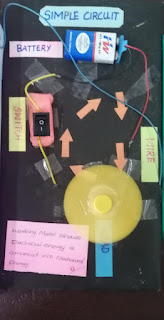Sharing My Experience as a Student Teacher: Building a Working Model of an Electric Circuit
As a student teacher, one of the most rewarding experiences I've had was creating a working model of an electric circuit with my class of 9th graders. The objective of this project was to make students aware of the conversion of electrical energy to mechanical energy, and we achieved this by constructing a simple yet effective model consisting of a motor, a small fan, a leaf switch, a battery, and connection wires. In this blog post, I want to share our journey and highlight the importance of hands-on learning in science education.
The Concept: Conversion of Electrical Energy to Mechanical Energy
Before delving into the construction of our working model, it's crucial to understand the concept we aimed to teach: the conversion of electrical energy to mechanical energy. This concept is fundamental in understanding how various devices, from electric fans to washing machines, operate. We wanted our students to grasp this principle through a practical and engaging experiment.
Materials Used:
Motor: We used a small, low-power electric motor. This motor would serve as the heart of our circuit, converting electrical energy into mechanical energy.
Small Fan: A small plastic fan was attached to the motor's shaft. This component would demonstrate the mechanical output of our circuit – the spinning of the fan blades.
Leaf Switch: To control the circuit and turn the motor on and off, we employed a leaf switch. This switch would complete or break the circuit, allowing us to control the flow of electricity.
Battery: A simple AA battery provided the electrical energy required to power our circuit.
Connection Wires: Wires were used to connect all the components together and create a closed circuit.
The Construction Process:
Building the Base: We started by creating a stable base for our model. This ensured that the motor and fan assembly would be securely mounted.
Mounting the Motor and Fan: We attached the motor to the base, making sure it was secure. The small fan was then fixed to the motor's shaft.
Wiring the Components: Using insulated wires, we connected the positive and negative terminals of the battery to the motor and the leaf switch. We used a simple parallel circuit setup.
Leaf Switch Placement: The leaf switch was strategically placed in the circuit. When pressed down, it completed the circuit, allowing electricity to flow, thus activating the motor and making the fan spin. Releasing the switch broke the circuit, turning off the motor.
Testing and Troubleshooting: Before presenting the model to the class, we tested it rigorously to ensure that everything worked smoothly. We also discussed the importance of safety precautions, such as avoiding short circuits.
The Learning Experience:
When we presented our working model to the class, the students were excited and engaged. They took turns operating the leaf switch and observed the fan spinning. We discussed the entire process, emphasizing how electrical energy from the battery was being converted into mechanical energy, resulting in the fan's rotation.
This hands-on experience allowed our students to:
Gain a deeper understanding of the conversion of energy from one form to another.
Develop problem-solving skills by troubleshooting any issues that arose during construction.
Appreciate the practical applications of electrical circuits in everyday life.
In conclusion, building a working model of an electric circuit to demonstrate the conversion of electrical energy to mechanical energy was an enriching experience for both the students and me as a student teacher. It showcased the power of experiential learning and highlighted the importance of practical demonstrations in science education. By actively engaging with the concept, our students were not only able to grasp the theory but also remember it better and apply it to real-world scenarios. This project served as a reminder that education is not just about textbooks; it's about inspiring curiosity and fostering a love for learning through hands-on experiences.

.jpeg)


Comments
Post a Comment